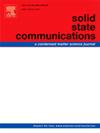Unlocking the potential of TiB5 monolayer as an appealing anode material for magnesium-ion batteries: A first-principles study
IF 2.4
4区 物理与天体物理
Q3 PHYSICS, CONDENSED MATTER
引用次数: 0
Abstract
Rechargeable magnesium-ion batteries (MIBs) have garnered extensive consideration as an exceptional alternative to lithium-ion batteries due to their high volumetric capacity, suitable reduction potential, good safety and low production cost; nonetheless, the lack of an outstanding anode material has significantly impeded the advancement of MIBs. Herein, we conducted a comprehensive first-principles calculation to assess the potential of a new-developed TiB5 monolayer as an anode material for MIBs. The projected band structure and density of states calculations reveal that the resulting TiB5 anode exhibits an intrinsic metallic behavior, primarily due to the B-band. Moreover, Mg ions are stably adsorbed on the TiB5 anode surface with an adsorption energy of −2.09 eV and a slightly high diffusion barrier of 1.25 eV. Based on the charge density difference, Bader charge, crystal orbital Hamiltonian population (COHP) and crystal orbital bond index (COBI) calculations, it is found the main interaction between Mg and TiB5 originates from the ionic Mg-B bonds. Remarkably, the TiB5 anode demonstrates a high specific capacity of 1577.77 mA h/g, a low average open circuit voltage of 0.22 V and a small lattice expansion of 1.30 %, outperforming many reported 2D anodes. Additionally, the TiB5 anode possesses excellent thermal stability without any Mg dendrite formation. These exceptional attributes highlight the potential of TiB5 monolayer as a perspective anode material for MIBs.
释放TiB5单层作为镁离子电池极具吸引力的负极材料的潜力:第一性原理研究
可充电镁离子电池(MIBs)由于其高容量、合适的还原潜力、良好的安全性和较低的生产成本,作为锂离子电池的一种特殊替代品,已经得到了广泛的考虑;然而,缺乏优秀的阳极材料严重阻碍了纳米电极的发展。在此,我们进行了全面的第一性原理计算,以评估新开发的TiB5单层作为mib阳极材料的潜力。预测的能带结构和态密度计算表明,所得到的TiB5阳极表现出固有的金属行为,主要是由于b带。Mg离子稳定吸附在TiB5阳极表面,吸附能为- 2.09 eV,扩散势垒略高,达到1.25 eV。通过电荷密度差、Bader电荷、晶体轨道哈密顿居布数(COHP)和晶体轨道键指数(COBI)计算,发现Mg与TiB5之间的主要相互作用来源于离子Mg- b键。值得注意的是,TiB5阳极具有1577.77 mA h/g的高比容量,0.22 V的低平均开路电压和1.30%的小晶格膨胀,优于许多报道的2D阳极。此外,TiB5阳极具有良好的热稳定性,不形成任何Mg枝晶。这些特殊的属性突出了TiB5单层作为纳米板阳极材料的潜力。
本文章由计算机程序翻译,如有差异,请以英文原文为准。
求助全文
约1分钟内获得全文
求助全文
来源期刊

Solid State Communications
物理-物理:凝聚态物理
CiteScore
3.40
自引率
4.80%
发文量
287
审稿时长
51 days
期刊介绍:
Solid State Communications is an international medium for the publication of short communications and original research articles on significant developments in condensed matter science, giving scientists immediate access to important, recently completed work. The journal publishes original experimental and theoretical research on the physical and chemical properties of solids and other condensed systems and also on their preparation. The submission of manuscripts reporting research on the basic physics of materials science and devices, as well as of state-of-the-art microstructures and nanostructures, is encouraged.
A coherent quantitative treatment emphasizing new physics is expected rather than a simple accumulation of experimental data. Consistent with these aims, the short communications should be kept concise and short, usually not longer than six printed pages. The number of figures and tables should also be kept to a minimum. Solid State Communications now also welcomes original research articles without length restrictions.
The Fast-Track section of Solid State Communications is the venue for very rapid publication of short communications on significant developments in condensed matter science. The goal is to offer the broad condensed matter community quick and immediate access to publish recently completed papers in research areas that are rapidly evolving and in which there are developments with great potential impact.
 求助内容:
求助内容: 应助结果提醒方式:
应助结果提醒方式:


